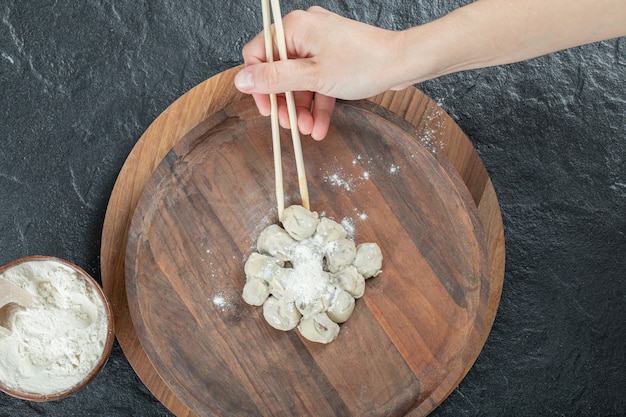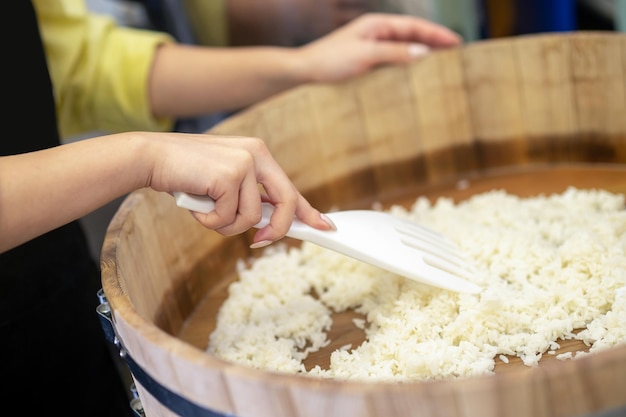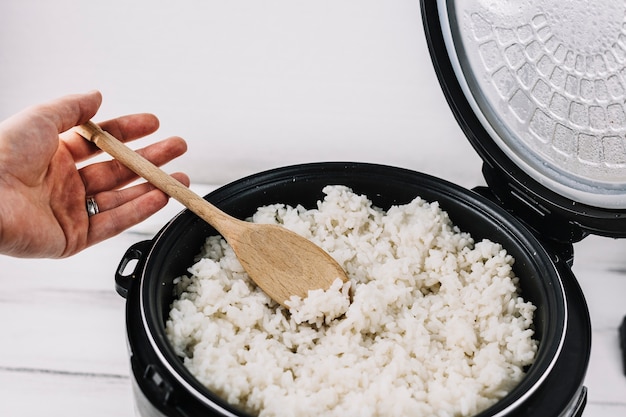There’s something truly magical about a plate of perfectly cooked sticky rice. It’s not just a side dish; it’s the heart and soul of countless Thai meals, a canvas for vibrant curries, a comforting companion for stir-fries, and a base for sweet and exotic desserts. It’s the fluffy texture, the gentle sweetness, and the captivating aroma that make it so utterly irresistible.
But I’ll admit, for a long time, I was terrified of making sticky rice. It seemed like a culinary mystery, a recipe for disaster waiting to happen. I’d follow instructions, but the results were never quite right—sometimes too hard, sometimes too mushy, and sometimes just bland and uninspired.
Then, one fateful day, I had a chat with a Thai friend who’s a bit of a culinary wizard. She shared some simple secrets, some insider tips, and suddenly, making sticky rice became a breeze. Now, I’m here to share those secrets with you, because everyone deserves to experience the joy of perfect sticky rice.
So, whether you’re a seasoned chef or a kitchen newbie, this guide will walk you through each step, from prepping the rice to achieving that perfect fluffy texture. Get ready to unlock a world of Thai flavour and discover the magic of sticky rice!
(Part 1) The Foundation: Essential Ingredients

Let's start by laying the groundwork. Making sticky rice isn't about fancy ingredients; it's about using the right ones, in the right way. You won’t need a shopping list, just these essential ingredients:
Sticky Rice (glutinous rice)
This is the star of the show, the magic ingredient that makes it all happen. It's called "glutinous rice" because of its high starch content, which gives it that sticky, almost glue-like quality. You'll find it in Asian grocery stores or online, usually in clear plastic bags. There are different varieties, but for a classic Thai experience, I stick with white sticky rice. It has a delicate flavour and a lovely soft texture.
Water
This is the cooking medium, the key to unlocking the rice's potential. I always use filtered water, which seems to give a fluffier result. It’s a small detail, but it makes a difference.
Salt
Just a pinch! It enhances the flavour and balances out the sweetness of the rice. A little goes a long way.
That’s it. It’s truly simple, which is part of the beauty of this recipe. Focus on getting the cooking process right, and you’ll be rewarded with the most delicious sticky rice you’ve ever had.
(Part 2) The Preparation: Washing and Soaking

Now, let’s prep our sticky rice. It’s a simple but essential step that ensures a perfectly cooked result.
Washing the Rice
First, give the rice a good rinse. I usually do this in a large bowl filled with cool water. Gently swish the rice around, releasing any excess starch or impurities. You’ll see the water turn cloudy. Repeat this process until the water runs clear. This is vital for preventing the rice from becoming overly sticky and clumpy.
Soaking the Rice (Optional but Highly Recommended)
After washing, it’s time for the soaking. This step is optional, but it’s my secret weapon for perfect sticky rice. Soaking the rice for at least 30 minutes, or even up to a couple of hours, helps it cook more evenly and creates a fluffier, less gummy texture. Just cover the rinsed rice with fresh water and let it sit. This is a great time to get your kitchen organized or prep any other ingredients.
(Part 3) The Magic: Cooking Your Rice

Here’s the fun part – cooking the rice. This is where the magic happens, where the humble grains transform into a delicious and satisfying side dish. I usually rely on my trusty rice cooker, but you can also cook it on the stovetop if that’s your preference.
Using a Rice Cooker (The Easy Way)
If you have a rice cooker, this is the easiest way to cook sticky rice. Simply drain the soaked rice (if you soaked it) and transfer it to the rice cooker. Most rice cookers have a specific setting for sticky rice, so follow the instructions on your model. I usually use a 1:1 ratio of rice to water, but it’s always good to check your rice cooker’s instructions. You may need to adjust the water level slightly depending on the type of sticky rice you’re using. The rice cooker will do the rest of the work, and you’ll be left with perfectly cooked rice.
Cooking on the Stovetop (For the Traditionalist)
Don’t worry if you don’t have a rice cooker! You can absolutely cook sticky rice on the stovetop. Here’s my method:
- In a medium saucepan with a lid, combine the rinsed and drained rice (if you soaked it) with the right amount of water. I usually use a 1:1.25 ratio of rice to water, but again, you might need to adjust this slightly depending on the rice you’re using.
- Add a pinch of salt to the water.
- Bring the water to a boil, then reduce the heat to low and cover the saucepan.
- Simmer the rice for 15-20 minutes, or until the water is absorbed and the rice is cooked through. You can check for doneness by gently pressing a grain of rice between your fingers. It should be soft and slightly sticky, but not mushy.
- Once the rice is cooked, remove the saucepan from the heat and let it rest for 5-10 minutes with the lid on. This allows the rice to steam and become even more fluffy.
(Part 4) The Final Touch: Fluffing Your Rice
The rice is cooked, but we’re not quite done yet! The final step is crucial: fluffing the rice. It may sound simple, but it makes a huge difference in texture and presentation.
The Importance of Fluffing
Fluffing the rice helps to separate the grains, preventing them from sticking together and creating a clumpy mess. It also allows the steam to escape, which helps to dry out the rice and gives it that airy, fluffy texture we all crave.
The Technique
To fluff the rice, gently use a fork or a wooden spoon to stir it around in the saucepan or rice cooker. Make sure to scrape the bottom and sides of the container, ensuring that the rice is evenly distributed.
If you’re using a rice cooker, your rice cooker may have a “keep warm” setting. This is perfect for keeping your rice warm while you finish preparing other dishes. If you’re cooking on the stovetop, keep the rice covered to maintain its warmth.
(Part 5) The Feast: Serving and Enjoying
And there you have it! Your perfectly cooked sticky rice is ready to be enjoyed. It’s incredibly versatile, and I’m always experimenting with new combinations. Here are some ideas to get you started:
Traditional Thai Delights
Sticky rice is the cornerstone of many traditional Thai dishes. It’s a perfect companion for:
- Green Curry: This creamy, aromatic curry, made with coconut milk, green chilies, and an array of vegetables and meats, is truly heavenly with sticky rice. The rice adds a contrasting sweetness and texture to the heat of the curry.
- Pad Thai: This classic stir-fried noodle dish is packed with flavour and is often served with a side of sticky rice. It’s a light and refreshing pairing, allowing the noodles and rice to play off each other perfectly.
- Mango Sticky Rice: This sweet and refreshing dessert features ripe mango slices served over a bed of sticky rice, drizzled with sweet coconut milk. It’s a perfect end to a delicious Thai meal, a delightful combination of textures and flavours.
Beyond Thai Cuisine: Other Delectable Options
But don’t limit yourself to traditional Thai dishes! Sticky rice is incredibly versatile and can be enjoyed in many ways. It’s an excellent addition to:
- grilled chicken or Fish: The slightly sweet flavour of sticky rice complements grilled chicken or fish beautifully. It adds a contrasting texture and a touch of sweetness that enhances the overall flavour profile.
- Stir-fries: Sticky rice is a great addition to any stir-fry, adding a touch of sweetness and texture. It's a great way to balance the savoury flavours of the stir-fry and create a more complete meal.
- Salads: The chewy texture of sticky rice can add an interesting dimension to salads, especially those with Asian-inspired flavours. It adds a unique texture and a touch of sweetness that elevates the salad.
Tips for Serving
Here are a few tips for serving sticky rice and making it look as good as it tastes:
- Use a Serving Spoon: Use a serving spoon to transfer the sticky rice to your plate. This helps maintain its texture and prevents it from becoming clumpy.
- Keep it Warm: Serve the sticky rice warm or at room temperature. Cold sticky rice can become a bit stiff and lose its appeal.
- Get Creative with Garnishes: Experiment with different garnishes, such as toasted sesame seeds, chopped peanuts, or chopped coriander. These add flavour, texture, and visual appeal to your rice.
(Part 6) Preserving Your Creation: Storing and Reheating
We’ve all been there: you’ve cooked a big pot of sticky rice, and you end up with leftovers. Don’t worry! It’s easy to store and reheat sticky rice, ensuring that it stays delicious even after it’s been cooked.
Storing
If you have leftovers, let the rice cool completely before transferring it to an airtight container. Store it in the refrigerator for up to 3-4 days.
Reheating
There are a few ways to reheat sticky rice and make it taste like it was just cooked:
- Microwave: Place the desired amount of rice in a microwave-safe dish, cover it with a damp paper towel, and microwave on high for 30-60 seconds, or until heated through. This is a quick and easy method, but it can sometimes make the rice a bit dry.
- Stovetop: Transfer the rice to a saucepan, add a splash of water, and heat over low heat, stirring occasionally, until heated through. This method seems to maintain the texture of the rice better than other methods.
- Rice Cooker: If you have a rice cooker with a "reheat" function, use that to reheat your rice. This is a convenient option, but make sure to check your rice cooker’s instructions.
(Part 7) Unveiling Secrets: Tips and Tricks
Throughout this guide, I’ve shared some of my favourite tips for making perfect sticky rice. Here are a few more secrets that I’ve picked up along the way:
- Don't Overcook: Overcooked sticky rice can become mushy and lose its texture. Keep an eye on the cooking time and avoid overcooking. A little undercooked is better than overcooked, as you can always cook it for a few extra minutes if needed.
- Adjust Water Ratio: The amount of water you use can significantly affect the texture of your rice. If you find your rice is too sticky, reduce the water ratio slightly in the future. If it’s too hard, increase the water ratio. It’s all about finding the perfect balance for your preferred texture.
- Experiment with Different types of rice: There are different varieties of sticky rice available, such as black sticky rice or brown sticky rice. Try them out and see which you prefer. Each variety has its own unique flavour and texture.
- Get Creative with Flavours: Don't be afraid to experiment with different flavours! You can add a pinch of sugar or a dash of vanilla extract to your rice for a sweet twist. You can also add a pinch of ground cinnamon or cardamom for a touch of warmth and spice.
(Part 8) Solving the Mysteries: FAQs
Let's clear up some common questions about sticky rice.
Q: Can I use regular rice to make sticky rice?
A: No, you cannot. Regular rice (like long-grain rice or basmati rice) doesn't have the same starch content as sticky rice. It won’t become sticky and will have a different texture. You need the high starch content of sticky rice to achieve that characteristic stickiness.
Q: What if my sticky rice is too sticky?
A: If your sticky rice is too sticky, you probably used too much water or overcooked it. Try reducing the water ratio slightly and cooking for a shorter time next time. Adjust the water ratio and cooking time until you find the perfect balance.
Q: What if my sticky rice is too hard?
A: If your sticky rice is too hard, it might not have been cooked long enough, or you didn’t use enough water. Try increasing the water ratio and cooking for a bit longer next time. Adjust the water ratio and cooking time until you find the perfect balance.
Q: Can I make sticky rice in advance?
A: You can definitely make sticky rice in advance! It’s a great way to save time and effort. Just cook the rice as usual, let it cool completely, and store it in an airtight container in the refrigerator for up to 3-4 days. When you’re ready to eat, you can reheat it using one of the methods mentioned above.
Q: What are some other Asian cuisines that use sticky rice?
A: Sticky rice is a staple in many Asian cuisines, not just Thai cuisine. It’s used in various dishes in countries like Vietnam, Cambodia, Laos, and Japan. Each country has its unique way of preparing and using sticky rice, creating a fascinating array of culinary traditions.
(Part 9) The Final Word: Conclusion
I hope this guide has given you all the information you need to confidently make delicious sticky rice. It’s a simple dish that can elevate any meal, and once you get the hang of it, you’ll wonder why you ever thought it was complicated! Remember, it’s all about finding the right balance of water and cooking time. Experiment, have fun, and enjoy the results!
You’ll be amazed by the versatility and deliciousness of sticky rice. So, go forth and create your own culinary masterpieces, and remember, there’s nothing quite like a plate of perfectly cooked sticky rice to make you feel happy, satisfied, and ready for a delicious adventure.
Everyone is watching

Prime Rib Roast Cooking Time Chart: Per Pound Guide
Cooking TipsPrime rib roast. Just the name conjures images of lavish dinners, crackling fires, and hearty laughter. It’s ...

How Long to Bake Potatoes in the Oven (Perfect Every Time)
Cooking TipsBaked potatoes are a staple in my kitchen. They're incredibly versatile, delicious, and surprisingly easy to m...

Perfect Rice Every Time: The Ultimate Guide to Cooking Rice
Cooking TipsAs a self-proclaimed foodie, I've always been a bit obsessed with rice. It's the foundation of countless cuisi...

The Ultimate Guide to Cooking Asparagus: Tips, Techniques, and Recipes
Cooking TipsAsparagus. The mere mention of this spring delicacy conjures up images of vibrant green spears, crisp and burs...

Ultimate Guide to Cooking the Perfect Thanksgiving Turkey
Cooking TipsThanksgiving. Just the word conjures up images of overflowing tables laden with delicious food, the scent of r...
